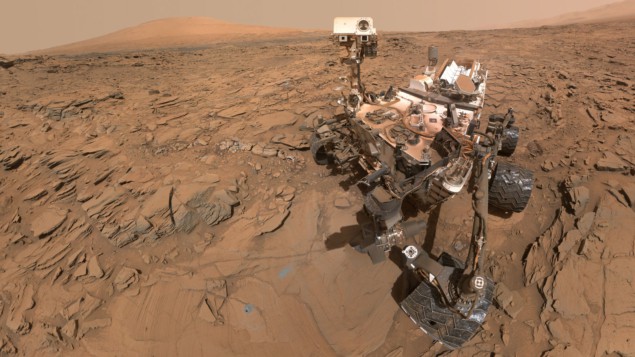
Organic molecules have been found in ancient rocks under the surface of Mars. The discovery was made by NASA’s Curiosity Rover by drilling into mudstone that was laid down 3.5 bn years ago at the bottom of a Martian lake. The molecules found include sulphur-rich thiophenes, aromatic hydrocarbons, such as benzene, and aliphatic hydrocarbons such as propane.
While the presence of these molecules does not prove that life once existed on the red planet, the discovery suggests that conditions on Mars could have been like those here on Earth when life first emerged more than 3 bn years ago.
The discovery is reported in the journal Science by NASA’s Jennifer Eigenbrode and an international team of scientists. They used Discovery’s Sample Analysis at Mars (SAM) instrument to examine samples that had been gathered from Mars’ Gale crater using a drill that can probe 5 cm below the surface.
SAM works by heating rock samples to release any organic compounds that may be present. The emitted gases are then analysed using a gas chromatograph mass spectrometer and a laser spectrometer.
This is not the first time that Curiosity has detected organic molecules, but previous measurements were considered unreliable because of possible sample contamination and unwanted chemical reactions.
Curioser and curioser
While such organic compounds could have been produced by ancient life – or could have provided a food source for ancient organisms – it is also possible that the molecules were created in the complete absence of life. “Curiosity has not determined the source of the organic molecules,” explains Eigenbrode.
Apparently barren and devoid of life today, scientists believe that Mars may have once been a more hospitable environment. Data gathered by Curiosity in 2015 suggests that the Gale Crater was once home to streams and lakes of liquid water. Now, scientists know that some of this water contained molecules that could be associated with life.

The long road to Mars
NASA associate administrator Thomas Zurbuchen says the agency wants to keep searching for signs of life on Mars. “With these new findings, Mars is telling us to stay the course and keep searching for evidence of life”.
In a second paper in Science, NASA’s Christopher Webster and an international team describe how they have used instruments on-board Curiosity to measure a seasonal variation in methane levels in the Martian atmosphere. The study, which ran for three Martian years (about five Earth years), found that methane concentration in the summer was nearly three times higher than in the winter. Webster and colleagues say that the variation cannot currently be explained by processes known to occur on Mars.



